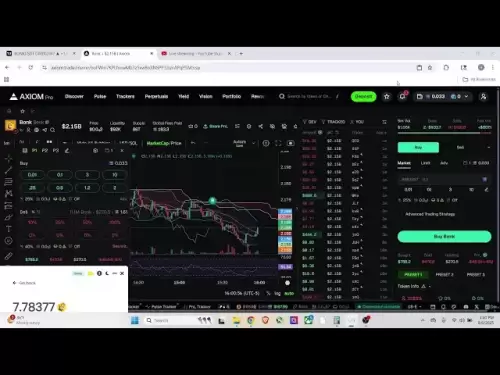-
 Bitcoin
Bitcoin $115100
1.27% -
 Ethereum
Ethereum $3675
2.71% -
 XRP
XRP $2.995
1.45% -
 Tether USDt
Tether USDt $1.000
0.02% -
 BNB
BNB $769.8
2.64% -
 Solana
Solana $168.0
3.25% -
 USDC
USDC $0.9999
-0.01% -
 TRON
TRON $0.3371
1.48% -
 Dogecoin
Dogecoin $0.2051
3.36% -
 Cardano
Cardano $0.7394
2.30% -
 Hyperliquid
Hyperliquid $38.15
0.42% -
 Stellar
Stellar $0.3966
-0.36% -
 Sui
Sui $3.486
2.93% -
 Chainlink
Chainlink $16.72
2.52% -
 Bitcoin Cash
Bitcoin Cash $568.0
4.36% -
 Hedera
Hedera $0.2440
2.59% -
 Ethena USDe
Ethena USDe $1.001
0.04% -
 Avalanche
Avalanche $22.16
2.06% -
 Litecoin
Litecoin $119.1
-0.73% -
 UNUS SED LEO
UNUS SED LEO $8.991
0.04% -
 Toncoin
Toncoin $3.232
-0.39% -
 Shiba Inu
Shiba Inu $0.00001233
2.82% -
 Uniswap
Uniswap $9.717
2.53% -
 Polkadot
Polkadot $3.664
1.85% -
 Dai
Dai $1.000
0.01% -
 Monero
Monero $281.2
-3.89% -
 Bitget Token
Bitget Token $4.350
1.55% -
 Cronos
Cronos $0.1428
5.07% -
 Pepe
Pepe $0.00001050
3.68% -
 Aave
Aave $262.3
3.54%
What is a Bitcoin quantitative contract
Bitcoin quantitative contracts, also known as BTC perpetual swaps, enable traders to speculate on BTC's price without physically holding it, providing leverage, 24/7 trading, shorting opportunities, and reduced risk.
Nov 11, 2024 at 05:06 am

What is a Bitcoin Quantitative Contract?
A Bitcoin quantitative contract, also known as a BTC perpetual swap, is a financial instrument that allows traders to speculate on the future price of Bitcoin (BTC) without the need to physically hold the underlying asset. It is a type of derivative contract that settles in cash, meaning that traders do not take delivery of the underlying BTC but instead receive a cash settlement based on the difference between the entry and exit prices of the contract.
Benefits of Bitcoin Quantitative Contracts:
- Leverage: Allows traders to gain exposure to the BTC market with a higher level of leverage than spot trading, potentially amplifying profits but also losses.
- 24/7 Trading: BTC quantitative contracts are traded on cryptocurrency exchanges 24 hours a day, 7 days a week, providing traders with constant access to the market.
- Shorting: Unlike spot trading, BTC quantitative contracts allow traders to profit from both rising and falling prices by shorting the asset.
- Reduced Risk: Margin trading with BTC quantitative contracts requires only a fraction of the capital needed for spot trading, reducing the overall risk.
How to Trade Bitcoin Quantitative Contracts:
- Choose a Reputable Exchange: Select a cryptocurrency exchange that offers BTC quantitative contracts and has a proven track record of reliability and security.
- Fund Your Account: Deposit funds into your exchange account in order to trade BTC quantitative contracts. Most exchanges support multiple deposit methods, including bank transfers, credit cards, and cryptocurrency deposits.
- Open a Trading Position: Once your account is funded, you can open a BTC quantitative contract position by specifying the desired leverage, entry price, and order type (limit order or market order).
- Monitor Your Position: It is crucial to monitor your BTC quantitative contract position regularly to manage risk and adjust your strategy accordingly. Exchanges typically provide real-time market data and charting tools to facilitate this.
- Close Your Position: To exit your BTC quantitative contract position, you need to place an opposite order that matches your entry position. For example, if you opened a long position, you would close it by placing a short order.
Potential Risks of Bitcoin Quantitative Contracts:
- Leverage Risk: High leverage magnifies both profits and losses, making it essential to trade responsibly and within your risk tolerance.
- Market Volatility: The BTC market is known for its volatility, which can lead to substantial price swings and potential losses.
- Liquidation: When market movements exceed your margin, your position may be liquidated automatically by the exchange to prevent further losses.
- Technical Glitches: Occasionally, exchanges may experience technical issues that can disrupt trading or result in unexpected liquidations.
Disclaimer:info@kdj.com
The information provided is not trading advice. kdj.com does not assume any responsibility for any investments made based on the information provided in this article. Cryptocurrencies are highly volatile and it is highly recommended that you invest with caution after thorough research!
If you believe that the content used on this website infringes your copyright, please contact us immediately (info@kdj.com) and we will delete it promptly.
- BlockDAG, Litecoin, and Cardano: Charting the Course in Crypto's Dynamic Waters
- 2025-08-07 09:09:06
- Fireverse Token: Igniting a Musical Revolution in Web3
- 2025-08-07 08:27:45
- Ethereum, L2 Withdrawals, and Decentralization: A New Yorker's Take
- 2025-08-07 08:32:33
- Avalanche vs. Ruvi AI: Daily Sales Tell a Story of Crypto Disruption
- 2025-08-07 06:29:35
- DeSoc: The Crypto to Buy Now for a Decentralized Future (and Maybe 43x Gains!)
- 2025-08-07 06:50:16
- Arctic Pablo Coin: Riding the Meme Coin Wave with a Deflationary Twist
- 2025-08-07 07:18:13
Related knowledge

Why is my Bitstamp futures position being liquidated?
Jul 23,2025 at 11:08am
Understanding Futures Liquidation on BitstampFutures trading on Bitstamp involves borrowing funds to open leveraged positions, which amplifies both po...

How to report Bitstamp futures for taxes?
Jul 30,2025 at 08:35am
Understanding Bitstamp Futures and Taxable EventsWhen trading Bitstamp futures, it’s essential to recognize that these financial instruments are treat...

Does Bitstamp offer inverse contracts?
Jul 23,2025 at 01:28pm
Understanding Inverse Contracts in Cryptocurrency TradingIn the realm of cryptocurrency derivatives, inverse contracts are a specific type of futures ...

What is the difference between futures and perpetuals on Bitstamp?
Jul 27,2025 at 05:08am
Understanding Futures Contracts on BitstampFutures contracts on Bitstamp are financial derivatives that allow traders to speculate on the future price...

How to find your Bitstamp futures trade history?
Jul 23,2025 at 08:07am
Understanding Bitstamp and Futures Trading AvailabilityAs of the current state of Bitstamp’s service offerings, it is critical to clarify that Bitstam...

Can I use a trailing stop on Bitstamp futures?
Jul 23,2025 at 01:42pm
Understanding Trailing Stops in Cryptocurrency TradingA trailing stop is a dynamic type of stop-loss order that adjusts automatically as the price of ...

Why is my Bitstamp futures position being liquidated?
Jul 23,2025 at 11:08am
Understanding Futures Liquidation on BitstampFutures trading on Bitstamp involves borrowing funds to open leveraged positions, which amplifies both po...

How to report Bitstamp futures for taxes?
Jul 30,2025 at 08:35am
Understanding Bitstamp Futures and Taxable EventsWhen trading Bitstamp futures, it’s essential to recognize that these financial instruments are treat...

Does Bitstamp offer inverse contracts?
Jul 23,2025 at 01:28pm
Understanding Inverse Contracts in Cryptocurrency TradingIn the realm of cryptocurrency derivatives, inverse contracts are a specific type of futures ...

What is the difference between futures and perpetuals on Bitstamp?
Jul 27,2025 at 05:08am
Understanding Futures Contracts on BitstampFutures contracts on Bitstamp are financial derivatives that allow traders to speculate on the future price...

How to find your Bitstamp futures trade history?
Jul 23,2025 at 08:07am
Understanding Bitstamp and Futures Trading AvailabilityAs of the current state of Bitstamp’s service offerings, it is critical to clarify that Bitstam...

Can I use a trailing stop on Bitstamp futures?
Jul 23,2025 at 01:42pm
Understanding Trailing Stops in Cryptocurrency TradingA trailing stop is a dynamic type of stop-loss order that adjusts automatically as the price of ...
See all articles

























































































